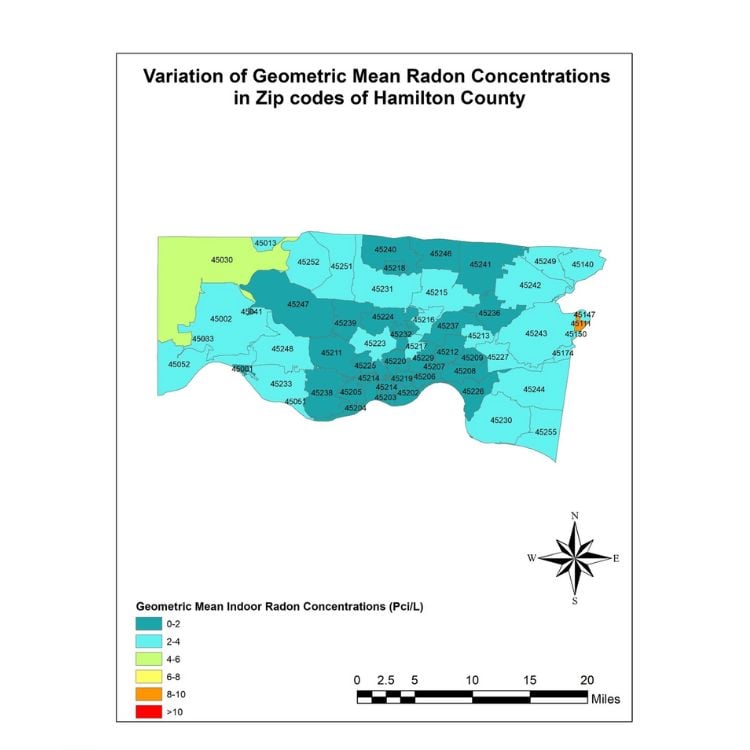Radon, a colorless and odorless radioactive gas, is a potential health hazard that can seep into homes from the ground. This silent danger has garnered increasing attention in recent years, and for good reason. Like many other areas, Cincinnati is not immune to radon infiltration, underscoring the importance of understanding its prevalence, potential risks, and the measures needed to safeguard our homes and loved ones.
The EPA Radon Zones
The Environmental Protection Agency (EPA) has divided the United States into three radon zones, each characterized by varying levels of potential radon exposure. These zones help homeowners and authorities identify regions where radon mitigation efforts might be particularly crucial. Let's take a closer look at these zones:

- Zone 1: This zone has the highest potential for elevated radon levels. It includes areas where predicted average indoor radon screening levels exceed four picocuries per liter (pCi/L), the EPA's recommended action level. Zone 1 areas require rigorous radon testing and found in regions with significant geological formations that allow radon to seep into homes more quickly.
- Zone 2: In this zone, predicted average indoor radon screening levels range between 2 and 4 pCi/L. While the risk is lower than in Zone 1, radon testing and mitigation are essential to ensure long-term safety.
- Zone 3: The lowest potential for radon exposure is found in Zone 3, where predicted average indoor radon screening levels are less than 2 pCi/L. While the risk is relatively lower in these areas, it's important to note that no level of radon exposure is entirely safe. Regular testing is a wise precaution, even in Zone 3.
The Importance of Testing
Understanding radon zones is just the first step in ensuring the safety of your home. Regardless of location, radon testing is a critical practice that should be a part of every homeowner's checklist. Since radon is both odorless and colorless, testing is the only reliable method to determine its presence and concentration.
Testing for radon is relatively simple and can be done using do-it-yourself test kits or by hiring a professional radon testing service. These tests provide accurate results that indicate whether radon levels in your home are within safe limits or require further action.
Radon Mitigation: Protecting Your Home and Family
Radon mitigation refers to reducing radon levels in a building to minimize health risks. If radon testing reveals elevated levels in your home, taking immediate action is essential to prevent long-term exposure. Radon mitigation techniques vary depending on the issue's severity, the building's construction, and other factors. Some standard mitigation methods include:
- Sub-slab Depressurization: This method involves installing a vent pipe system that draws radon from beneath the building and safely releases it into the outdoor air.
- Ventilation: Improved ventilation can help dilute radon concentrations indoors, reducing the risk of exposure.
- Sealing Cracks: Sealing cracks and openings in the foundation can prevent radon from entering the home in the first place.
- Crawl Space Mitigation: Homes with crawl spaces can be especially vulnerable to radon infiltration. Crawl space encapsulation and ventilation can help mitigate radon levels.
- Professional Assistance: For more complex cases, it's recommended to seek the expertise of a professional radon mitigation contractor who can assess your home's specific needs and implement appropriate solutions.
Radon is a hidden threat that can compromise the health and safety of our homes. Like those in many other areas, Cincinnati residents need to be aware of radon zones and the potential risks associated with radon exposure.
Regular testing is essential to catch any elevated radon levels early, regardless of location. If testing reveals high concentrations of radon, don't panic.
Effective radon mitigation strategies are available to protect your home and loved ones, ensuring a safe and secure living environment for years.


.jpg?width=750&height=750&name=radon%20levels%20by%20county%20ohio_the%20geiler%20comapany%20(1).jpg)


